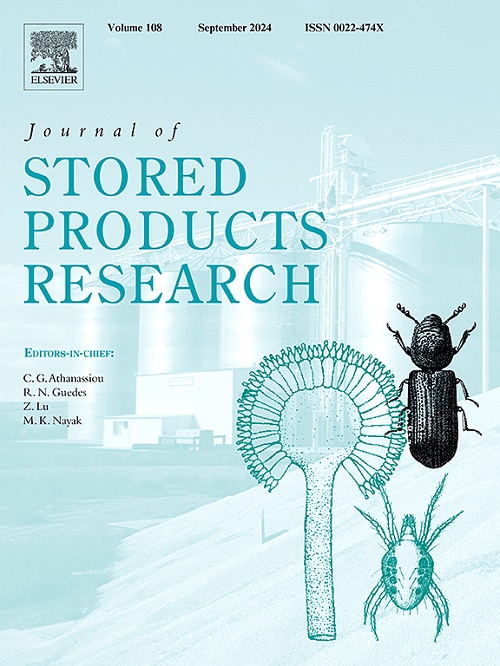Chemical cues in grain storage: A review on semiochemical types, pest behavior, and control strategies
IF 2.7
2区 农林科学
Q1 ENTOMOLOGY
引用次数: 0
Abstract
The excessive reliance on synthetic chemical pesticides has led to adverse environmental impacts, prompting the exploration of sustainable alternatives like semiochemicals (pheromones and allelochemicals) for pest management. These chemical compounds offer innovative approaches to controlling stored product insects, which pose significant threats to global food security by infesting and degrading grains and stored food products. This review delves into different kinds of semiochemicals, their action mechanism, and their applications in insect control methods, including mass trapping, mating disruption, attract-and-kill, and push-and-pull strategies. Recent advancements at the molecular level, particularly in understanding pheromone receptors, have enhanced insights into insect recognition and response to chemical signals. Different kinds of semiochemicals and their roles in managing stored grain pests belonging to Coleoptera, Lepidoptera, and Psocoptera are discussed. Additionally, the effectiveness of various pheromone-based traps, such as sticky, funnel and cone, pitfall, and light-activated traps, in grain storage monitoring are discussed, along with insights from field and laboratory case studies. Integration of pheromone traps with biological, chemical, and mechanical control methods is examined to highlight the potential for holistic pest management strategies. Despite their effectiveness, challenges such as environmental variability and species-specific responses persist. Future directions emphasize innovations in pheromone synthesis, trap design, and interdisciplinary approaches to enhance scalability and applicability across diverse storage ecosystems. This review underscores the critical role of semiochemical-mediated techniques in reducing stored product losses, offering a sustainable and effective alternative to chemical pesticides.
粮食储存中的化学线索:符号化学类型、害虫行为和控制策略的综述
对合成化学农药的过度依赖导致了对环境的不利影响,促使人们探索可持续的替代品,如半化学物质(信息素和化感化学物质)用于虫害管理。这些化合物提供了控制储藏产品昆虫的创新方法,这些昆虫通过侵染和降解谷物和储藏食品对全球粮食安全构成重大威胁。本文综述了不同类型的昆虫符号化学物质及其作用机制,以及它们在昆虫防治方法中的应用,包括大规模诱捕、干扰交配、吸引-杀死和推-拉策略。最近在分子水平上的进展,特别是对信息素受体的理解,增强了对昆虫识别和对化学信号反应的认识。本文讨论了不同类型的半化学物质及其在储粮害虫(鞘翅目、鳞翅目和鞘翅目)治理中的作用。此外,本文还讨论了各种信息素诱捕器的有效性,如粘性诱捕器、漏斗和锥型诱捕器、陷阱诱捕器和光激活诱捕器,以及来自实地和实验室案例研究的见解。综合信息素陷阱与生物,化学和机械控制方法进行了检查,以突出害虫整体管理战略的潜力。尽管它们很有效,但环境变异性和物种特异性反应等挑战仍然存在。未来的发展方向强调信息素合成、陷阱设计和跨学科方法的创新,以增强不同存储生态系统的可扩展性和适用性。这篇综述强调了半化学介导技术在减少储存产品损失方面的关键作用,为化学农药提供了一种可持续和有效的替代品。
本文章由计算机程序翻译,如有差异,请以英文原文为准。
求助全文
约1分钟内获得全文
求助全文
来源期刊
CiteScore
5.70
自引率
18.50%
发文量
112
审稿时长
45 days
期刊介绍:
The Journal of Stored Products Research provides an international medium for the publication of both reviews and original results from laboratory and field studies on the preservation and safety of stored products, notably food stocks, covering storage-related problems from the producer through the supply chain to the consumer. Stored products are characterised by having relatively low moisture content and include raw and semi-processed foods, animal feedstuffs, and a range of other durable items, including materials such as clothing or museum artefacts.

 求助内容:
求助内容: 应助结果提醒方式:
应助结果提醒方式:


